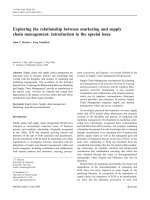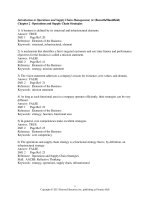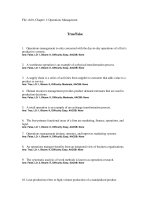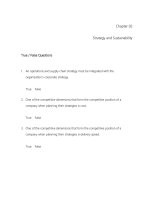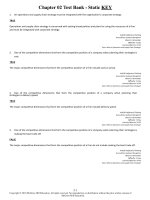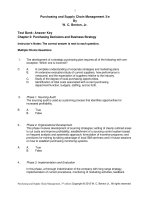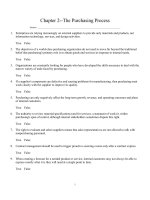Purchasing and supply chain management strategies and realities
Bạn đang xem bản rút gọn của tài liệu. Xem và tải ngay bản đầy đủ của tài liệu tại đây (768 KB, 378 trang )
xiv
i
Purchasing and Supply
Chain Management:
Strategies and Realities
Michael Quayle
University of Glamorgan, UK
IRM Press
Publisher of innovative scholarly and professional
information technology titles in the cyberage
Hershey • London • Melbourne • Singapore
ii
Acquisitions Editor:
Development Editor:
Senior Managing Editor:
Managing Editor:
Copy Editor:
Typesetter:
Cover Design:
Printed at:
Michelle Potter
Kristin Roth
Amanda Appicello
Jennifer Neidig
Becky Shore
Sharon Berger
Lisa Tosheff
Integrated Book Technology
Published in the United States of America by
IRM Press (an imprint of Idea Group Inc.)
701 E. Chocolate Avenue, Suite 200
Hershey PA 17033-1240
Tel: 717-533-8845
Fax: 717-533-8661
E-mail:
Web site:
and in the United Kingdom by
IRM Press (an imprint of Idea Group Inc.)
3 Henrietta Street
Covent Garden
London WC2E 8LU
Tel: 44 20 7240 0856
Fax: 44 20 7379 0609
Web site:
Copyright © 2006 by Idea Group Inc. All rights reserved. No part of this book may be reproduced, stored or distributed in any form or by any means, electronic or mechanical, including
photocopying, without written permission from the publisher.
Product or company names used in this book are for identification purposes only. Inclusion of the
names of the products or companies does not indicate a claim of ownership by IGI of the
trademark or registered trademark.
Library of Congress Cataloging-in-Publication Data
Purchasing and supply chain management : strategies and realities / Michael Quayle, editor.-- 1st ed.
p. cm.
Summary: "This book shows readers how to develop supply chain strategy and implementation
and use it gain an advantage in the 21st century competitive marketplace"--Provided by publisher.
Includes bibliographical references and index.
ISBN 1-59140-899-7 (hardcover) -- ISBN 1-59140-900-4 (softcover) -- ISBN 1-59140-901-2
(ebook)
1. Business logistics--Management. 2. Strategic planning. I. Quayle, Michael, 1947HD38.5.P87 2006
658.7--dc22
2005023882
British Cataloguing in Publication Data
A Cataloguing in Publication record for this book is available from the British Library.
All work contributed to this book is new, previously-unpublished material. The views expressed in
this book are those of the authors, but not necessarily of the publisher.
iii
Purchasing and Supply
Chain Management:
Strategies and Realities
Table of Contents
Foreword .......................................................................................... viii
Preface ............................................................................................... ix
Chapter I.
Developments in Purchasing and Supply Chain Management
and Logistics .................................................................................. 1
Procurement, Purchasing, Outsourcing, Supply Management and
Supply Chain Management ......................................................... 1
The Sustainable Supply Chain ......................................................... 9
Resource-Based View and Competitive Advantage ........................ 10
Business Issues in the 21st Century ................................................. 13
Supply Chains into the Future ....................................................... 14
Supply Chain Education ................................................................ 16
Professional Competence: Food for Thought ................................ 19
Chapter II.
Strategic Purchasing Management ................................................... 21
Corporate Planning ...................................................................... 21
Purchasing Planning and Purchasing Strategies ........................... 27
Corporate and Environmental Factors ......................................... 29
Strategic Planning ........................................................................ 29
Market Strategic Flexibility........................................................... 30
Objectives and Responsibilities ...................................................... 30
iv
SWOT and Gap Analysis ............................................................... 32
Functions Involved in Corporate Planning .................................... 33
Functional Contribution to Corporate Strategy............................. 34
Monitoring Performance ............................................................... 35
Purchasing Needs and Corporate Strategies ................................. 36
Purchasing Strategies ................................................................... 38
Flexible Strategies......................................................................... 41
International Trade: Implications for Purchasing
Management ............................................................................ 44
Ethical Purchasing ........................................................................ 47
Procurement Agencies .................................................................. 48
Food for Thought .......................................................................... 49
Chapter III.
Purchasing Policy .............................................................................. 50
Policy Issues .................................................................................. 50
Selecting Overall Policy ................................................................ 53
Structure of Purchasing Organisation ........................................... 53
Structure of the Purchasing Function in Simple Organisations ...... 54
Division of Work amongst Buying Groups ..................................... 57
The Position of Purchasing Management in the Organisation ....... 59
Structure of the Purchasing Function in Complex Organisation .... 60
A Multilevel Structure for Purchasing Management ...................... 63
Other Methods of Achieving Coordination .................................... 65
The Selection of an Appropriate Structure for Particular
Circumstances .......................................................................... 66
Multinational Supplies Structures .................................................. 67
Public Sector ................................................................................. 68
Benchmarking ............................................................................... 69
Materials Management.................................................................. 71
Exemplar Case Study: Procurement Business Strategy .................. 73
Chapter IV.
Quality Management and Customer Service .................................... 89
Defining Quality ............................................................................ 89
Design and Conformance .............................................................. 92
The Costs of Quality ...................................................................... 93
Efficient Consumer Response ........................................................ 99
Total Quality Management .......................................................... 100
Food for Thought ........................................................................ 103
v
Chapter V.
Supply Chain Management ............................................................. 104
The Role of Supply Chain Management ....................................... 104
The Supply Chain Mix ................................................................. 107
The Scope of the Supply Chain .................................................... 109
The Value Chain and Interlock Strategy ...................................... 113
Chapter VI.
Managing the Supply Chain Function ............................................. 120
Staffing the Department .............................................................. 121
Operating Manuals...................................................................... 124
Qualities of Supply Chain Personnel ............................................ 125
Recruiting Personnel ................................................................... 126
Managing the Department .......................................................... 130
Implications for Supply Chain Management ................................ 133
Management and Implementation of Change .............................. 133
Supply Chain and Change ........................................................... 135
Chapter VII.
Operating Environments ................................................................. 138
Integrated Logistic Support ......................................................... 138
ILS Management Structure.......................................................... 143
Level of Repair Analysis .............................................................. 148
Logistics Information Systems ..................................................... 150
Logistics and Other Organisational Functions ............................. 155
Chapter VIII.
Provisioning and Inventory Control ................................................ 161
Provisioning ................................................................................ 161
The Use of Computers ................................................................ 171
The Objectives of an Inventory Control System ........................... 174
Method of Inventory Control ....................................................... 180
Cost of Inventory Investment ...................................................... 185
Inventory Control and Accounting Methods ................................ 187
Pricing Issues .............................................................................. 189
Price Analysis ............................................................................. 195
Inventory in the Final Accounts................................................... 196
Identification and Coding of Materials ........................................ 198
Development of the Coding System ............................................. 205
vi
The Stores Vocabulary ................................................................ 210
Inventory Reduction .................................................................... 217
Review of Other Concepts ........................................................... 221
Materials Requirements Planning ................................................ 224
Manufacturing Resource Planning .............................................. 226
Chapter IX.
Stores Management ....................................................................... 228
Stores Management Objectives ................................................... 228
The Siting of Stores Buildings and Stockyards ............................. 230
Construction of the Buildings and Stockyards ............................. 231
Stockyards .................................................................................. 233
Internal Layout ........................................................................... 233
Detailed Planning of Layouts ...................................................... 234
Types of Stores ............................................................................ 235
Special Storage Facilities ............................................................ 240
Planning Storage Equipment ....................................................... 242
Handling Equipment ................................................................... 245
Types of Handling Equipment ..................................................... 248
Security ....................................................................................... 255
Safety and Safe Methods of Working ........................................... 256
Case Studies ................................................................................ 260
Chapter X.
Transport ........................................................................................ 264
Introduction ................................................................................ 265
Fleet Management ...................................................................... 266
Vehicle Scheduling ...................................................................... 269
Maintenance and Security ........................................................... 273
Facilities for Maintenance ........................................................... 273
Quality Control ........................................................................... 274
Security ....................................................................................... 275
Containers, Unitisation and Palletisation .................................... 276
Mechanical Aids to Loading and Off-Loading ............................. 280
Loading and Unloading Equipment Available on Vehicles........... 282
Road Vehicle Design and Road Planning ..................................... 282
Road Haulage ............................................................................. 287
Operating Costs of Own Fleet ..................................................... 291
Rail Freight ................................................................................. 295
vii
Air Freight .................................................................................. 297
Food for Thought ........................................................................ 300
Case Study .................................................................................. 301
Chapter XI
Physical Distribution ....................................................................... 303
Distribution ................................................................................. 303
Distribution Planning .................................................................. 304
Logistics and Delivery Planning .................................................. 307
Budgetary Control in Distribution ............................................... 312
Food for Thought ........................................................................ 315
Case Study .................................................................................. 317
United Parcel Service ................................................................. 318
Modelling Systems ....................................................................... 318
Radio Frequency Identification.................................................... 319
Chapter XII.
E-Business ...................................................................................... 320
A Definition of Electronic Data Interchange................................ 320
Why Use EDI?............................................................................. 323
Viewpoint .................................................................................... 340
References and Bibliography.......................................................... 342
About the Author............................................................................. 355
Index ............................................................................................... 356
viii
Foreword
For too long the emphasis on logistics in academia has focused on the economics of time and place and the physical movement of materials and finished
goods. How refreshing to see a new book by Michael Quayle, which looks at
logistics and the supply chain in the widest sense. This book looks at current
thinking and development of the supply chain concept through purchasing and
purchasing policies. Management issues surrounding quality, and value chain
and controls within the supply chain follow. This is not a theoretical treatise but
rather a look at various operating environments that will change emphasis within
supply chain. It looks at the balance between service levels and profitability.
This logically leads to issues such as inventory control and the alternative to
holding stock and all the implications surrounding warehousing. Stores management is covered in considerable detail, giving current thinking on all aspects of
storage of goods.
Next, Michael considers transport, including the issues surrounding exports and
imports. This is, in itself, a valuable reference to current practice. He next
covers physical distribution and concepts of channel formation, and this is a
comprehensive treatment of current thinking. Finally, he addresses e-business
and the capture of information as a resource to be managed. I found this to be
a stunning book that will reach a wide audience, because - every supply chain,
logistics, production, purchasing, and service manager must have it as an office
reference book.
Sir Roger S. Jones, OBE
ix
Preface
This first edition of Purchasing and Supply Chain Management: Strategies
and Realities has been produced in response to market demand. I have developed and reinforced the concept of purchasing and supply chain management
as a dynamic and managerial process, and have added material that reflects the
current more general view of purchasing and supply chain management as a
strategic function. The terrorist attacks of September 11, 2001, in the United
States of America, subsequent impacts, and other worldwide tragic events resulting from the war on terror have created a need to revisit how we achieve
effective purchasing and supply chain management. Post 9/11 has had no effect? On September 11, 2001, terrorists left their mark of murder and took the
lives of many citizens. With the passing of months and years, it is the natural
human desire to resume a quiet life and to put that day behind us, as if waking
from a dark dream. The hope that danger has passed is comforting, is understanding, and is false. The attacks that followed on Bali, Jakarta, Casablanca,
Bombay, Mombassa, Najaf, Jerusalem, Riyadh, Baghdad, and Istanbul, for example (and indeed London in July 2005), were not dreams. They are part of the
global campaign by terrorist networks to intimidate and demoralize all who oppose them (Bush, 2003).
Ask those trans-Atlantic and trans-America passengers and airlines who have
had flights cancelled because of terrorist concerns. Ask customers, purchasers,
and suppliers worldwide who have seen shipping costs and timescales increase
as enhanced security measures are embodied. The threat matrix is a clear and
present danger. Similarly, on a humanitarian scale, integration of purchasing
and supply chain management and a sharing of resources can be a crucial
element in international disaster relief. Indeed, integrative practices are an important area in the effectiveness of purchasing and supply chain management.
In general, however, the 21st century events such as the Iranian earthquake and
the Asian tsunami disaster suggest the world still has much to learn in terms of
integrating resources in order to achieve supply chain effectiveness. Conse-
x
quently, I have attempted to reflect the emergence of purchasing and supply
chain management and e-business as a 21 st century activity recognised as key
to corporate social responsibility and sustainability in both the public and private
sectors. The text will be useful to a broad range of students and practitioners,
and the practical style will be popular. Thanks are due to colleagues and friends
who have contributed their ideas and advice and to the business concerns and
copyright holders of included material. Specific acknowledgments and references are, of course, given in the book where appropriate. I am particularly
grateful to my colleagues Bryan Jones and Neil Fuller for their support and
agreement to use their material. The book is organised into 12 chapters:
Chapter I: Developments in Purchasing and Supply Chain Management and Logistics, discusses procurement, purchasing, outsourcing, supply
management and supply chain management; buying links in the supply
chain; resource-based view; business issues affecting organisations; supply chains into the future; supply chain education; professional competence; and business issues in the 21 st century.
Chapter II: Strategic Purchasing Management, discusses corporate planning, purchasing planning and strategies, corporate and environmental factors, SWOT (Strengths, Weaknesses, Opportunities, Threats) gap analysis, flexibility, buying decisions, buying practice, ethical purchasing, procurement agencies, purchasing needs and corporate strategies, single vs.
multiple sourcing, and factors affecting purchasing strategy.
Chapter III: Purchasing Policy, discusses structure; definition and purpose, centralisation and decentralisation in complex organisations, purchasing consortia, policy issues, the public sector, benchmarking, and exemplar
purchasing strategy.
Chapter IV: Quality Management and Customer Service, discusses definitions, costs of failure, ISO9000, ISO14000, total quality management,
the TQM diamond, quality & service as competitive variables, partnering,
efficient consumer response.
Chapter V: Supply Chain Management, discusses definitions and concepts, the value chain, the bullwhip effect, logistics management and corporate profit, global sourcing, public sector and military variations, logistics in small organisations, interlock strategy, and bottlenecks.
Chapter VI: Managing the Supply Chain Function, discusses directing
the function, staff, resources, job description, motivation, professional and
supervisory management, management and implementation of change, impact of change on people and jobs, effect on performance, scope for more
creative work and decision making, and the supply chain and change.
xi
Chapter VII: Operating Environments, discusses logistic action planning;
manufacturing, public services, and utilities; the armed forces; construction, retailing, and distribution; integrated logistics support; logistics information systems; case study; coordination of physical control; and contribution to overall profitability and service capability.
Chapter VIII: Provisioning and Inventory Control, discusses stores links
in the chain, the need to hold stock, provisioning, pareto analysis, use of
computers, coding and inventory systems, related effects on standardisation
and variety reduction, accounting methods, stores vocabulary, price analysis, economic order quantity, inventory reduction and control, liaison with
sales and production, application of JIT (Just in Time) concepts, and MRP
(Multiple Resource Planning) and MRPII, and point of sale (POS).
Chapter IX: Stores Management, discusses warehouse, storehouses,
stockyards, depots; location and distribution networks. Premises: determination of handling requirements in relation to products (e.g., perishables,
fluids, gases); design and layout; movement patterns and volume throughput; cost factors; and environmental factors. Operational requirements:
automation, security, hazardous stocks, preservation, packaging, housekeeping, accounting; personnel: development of teams; health and safety;
and training. Equipment: degrees of automation, applications of robotics;
static and mobile equipment; surplus, scrap and obsolescent stocks; and
treatment and disposal.
Chapter X: Transport, discusses modes; alternative methods of transportation; performance variables; road, rail, air and sea transport: optimisation;
roll on/roll off arrangements; and import/export documentation and procedures. Management considerations: procurement of transport services;
purchase, lease and hire options; licensing; traffic regulation; transport
laws; scheduling and planning and utilisation, containerisation; and control
and monitoring of costs.
Chapter XI: Physical Distribution, discusses despatch and delivery; resource planning, distribution channels; management; distribution audits;
budgetary control; coordination; and military logistics.
Chapter XII: E-Business, discusses electronic data interchange, information as a resource to be managed, evaluation of e-commerce systems,
what the literature says, e-business strategies, opportunities for coherent
procurement, tantric purchasing, hype versus reality, and case study.
As you can see, this book is about decision making and actions that determine
whether an organisation excels, survives, or dies. This process is called purchasing and supply chain management. The job of purchasing and supply chain
managers is to make the best use of an organisation s resources in a changing
xii
environment. This book focuses on top-level decisions, but you should not have
a problem with the relevance of the subject matter for your short-term career
interests. Several reasons can be given for why the knowledge you can gain in
the study of purchasing and supply chain management is practical and useful
for your career: You are likely to perform better in your function, regardless of
your level in the organisation, if you know the direction in which the organisation
is going. As the manager of a subunit, you would like to know how what you do
fits into the broader picture. If you know how your function contributes, you
should be able to do a better job of helping the organisation reach its objectives.
If your unit is successful, and higher level managers realise how you contributed to this success, it will reflect positively on you. Furthermore, lower level
units often interpret strategies and policies set at higher levels. If you understand why those were established, you can implement them more effectively.
Finally, if you understand how your job relates to others in the organisation, you
will be in a better position to effectively work with peers when cooperation is
called for and compete for resources when the time comes.
In your study of purchasing and supply chain management process you will
begin to identify factors that may lead to significant changes in the organisation.
Some of these strategic changes could be positive or negative to you personally. For instance, a major divestiture could eliminate your unit, or a new market
thrust or product development could make your unit more critical for
organisational performance. If you understand what factors may be pushing
the organisation in certain directions and how your job fits in, you might decide
to change or keep your job. Foresight about critical organisation changes can
be a real asset to your career. If you are aware of the strategies, values, and
objectives of higher level managers, you are in a better position to assess the
likelihood of acceptance of proposals you might make. As you consider offering your suggestions, tying the reasons to your assessment of the interest of
higher level managers is likely to enhance their acceptance and your visibility.
Thus, I believe that an understanding of how and why supply chain decisions
are made can be helpful to you in terms of securing resources beneficial to your
subunit, improving your job performance, and enhancing your career development. This book s purpose is to help you make sense of the supply chain management process while you are a first-line manager or a middle manager. It is
also designed to help prepare you to become a successful top manager. Its goal
is to show you that if you understand the business policy and purchasing and
supply chain management process before you get to the top, you will be a more
effective manager. The book is also designed to fulfill a teaching function at
postgraduate, professional and undergraduate level in schools of business management and administration. The material is designed to help you integrate the
functional tools you have learned. These include the analytical tools of purchasing and supply chain, such as physical distribution, logistics and purchasing
xiii
management. All these provide help in analysing business problems. Remember that purchasing and supply chain management is about people, not just about
processes. This book and the materials in it provide you with an opportunity to
learn when to use which tools and how to deal with trade-offs when you cannot
maximise the results or preferences of all the functional areas simultaneously.
More important
enjoy it!
xiv
Developments in Purchasing and Supply Chain Management and Logistics
1
Chapter I
Developments in
Purchasing and Supply
Chain Management
and Logistics
The purpose of this chapter is to provide an overview of the differences between
procurement, purchasing, outsourcing, supply, and, sustainable supply chain
management. An overview of the global marketplace and the emerging business
issues of the 21 st century will also be provided, along with some guidance on
effective education programmes. Supply chain management a crucial element of
competitive advantage (see, e.g., Figure 1).
Understanding what supply chain management is and what it means is vital.
Procurement, Purchasing,
Outsourcing, Supply Management
and Supply Chain Management
Supply chain management is not merely a fashionable set of words for supply,
purchasing, and procurement! Understanding the differences is crucial to the
development of a world-class culture.
Copyright © 2006, Idea Group Inc. Copying or distributing in print or electronic forms without written
permission of Idea Group Inc. is prohibited.
2 Quayle
Figure 1. Competitive advantage (UK competitiveness moving forward to
the Next Stage DTI Economics paper no. 3; Porter & Ketels, 2003)
Procurement
Compton and Jessop (1995, p.26) defined procurement as “the obtaining by
various means (e.g., loan, transfer, hire purchase) of supplies and services with
or without consideration.” Van Weele and Rozemeijer (1996, p.22) defined
procurement as including “all activities required in order to obtain the product
from the supplier and get it to the place where it is actually used. It encompasses
the purchasing function, store, traffic and transportation, incoming inspection,
and quality control and assurance. Some firms also include salvage and management of environmental issues (as they are related to materials) in procurement.”
Another definition might be that procurement is purchasing, contracting, and
logistics, wherein logistics is taken to be inventory control, warehousing,
transport, quality assurance, and control. The distinction between purchasing
and contracting is that contracting is usually the purchasing activity associated
with major works.
Often the term procurement is used, especially where government purchasing
is involved. The specific activities of purchasing are, as described by Dobler
(1990, p.100), “participation in the development of requirements and their
specifications; managing value analysis activities; conducting supply market
research; managing supplier negotiations; conducting traditional buying activities; administering purchase contracts; managing supplier quality; buying inbound transportation.”
Copyright © 2006, Idea Group Inc. Copying or distributing in print or electronic forms without written
permission of Idea Group Inc. is prohibited.
Developments in Purchasing and Supply Chain Management and Logistics
3
Purchasing
Dooley (1995) argued that purchasing and supply management has emerged as
an important strategic area of management decision making. Porter (1987)
referred to the “value chain” as fundamental to the performance of an organisation.
In this value chain, inbound and outbound logistics and management of the
manufacturing operations are prominent. Deming (1988) dealt with “supply
chain” concepts as crucial to the successful introduction of TQM (Total Quality
Management). Other references to this growing significance of the functions of
purchasing and supply include Crosby (1979), Schonberger (1986), Womack et
al. (1991), and Lamming (1993). Purchasing has two main purposes: to purchase
for resale and to purchase for consumption or for conversion (Dobler, 1990).
Merchants and speculators purchase for resale, and their task is knowing the
final market for commodities so that, almost regardless of the cost of purchase,
the on-sale can be made at a profit. Purchasing for consumption or for conversion
requires a far more difficult decision. First, it is often a long-term decision (e.g., the
decision to use gas as a source of energy). Second, although there are many
different purchasing decisions, they are not repeated so often that a mistake can
have long-term damaging effects, such as the decision to use a particular make of
alternator in the assembly of a motor-vehicle engine (Dooley, 1995).
The clear definition of purchasing is given by Elliott-Shircore and Steele (1985),
who stated that purchasing is the process by which a company (or other
organisation) contracts with third parties to obtain goods and services required
to fulfil its business objectives in the most timely and cost-effective manner. The
terms purchasing and procurement are often used interchangeably; however,
there might be a distinction in that purchasing is more concerned with establishing
and managing a commercial relationship, whereas procurement is also concerned with the more physical material or service delivery control aspects after
the contract has been let or the order placed. Van Weele and Rozemeijer (1996)
suggested a possible model for future purchasing organisations to make simultaneous improvements in increasing both functional expertise and horizontal
synergy and in improving focus and flexibility at the business unit level could be
the hard-core/soft-core organisation. In this organisation, a small, centralised
hard core of corporate purchasing professionals is surrounded by a rather fluid
soft core of business specialists. The hard core is responsible for the purchasing
process; the strategy; the professional development; and the recruitment,
training, and development of the people involved in the purchasing process. Van
Weele and Rozemeijer also use the term the virtual purchasing organisation
to describe their vision of what is now required. I see absolutely no reason why,
for example, a group of small- and medium-sized enterprises could not develop
a “core” purchasing activity. Indeed, much has been written about what is now
required of suppliers. Myer (1989) was an early proponent of supplier change
Copyright © 2006, Idea Group Inc. Copying or distributing in print or electronic forms without written
permission of Idea Group Inc. is prohibited.
4 Quayle
and argued that if suppliers hope to regain a measure of control over their destiny,
they must assert themselves and take responsibility for managing their customers. In doing this, suppliers face challenges in two realms: reallocating resources
in the company and redesigning programs to better serve outside customers. This
should be small- and medium-sized enterprise philosophy. Purchasers, suppliers,
and customers are inevitably involved in sourcing strategies and decisions — the
genesis of obtaining goods and/or services in both the public and private sectors.
Clearly, these groups need to work together to secure competitive advantage
and/or world class status.
Outsourcing
Hendry (1995) suggested that one of the strongest and most sustained trends
within business over the last 10 years has been the trend towards outsourcing.
With increased fervour and conviction, corporations have sought to reduce costs
by contracting out services and activities traditionally provided in house. The
rationale of this movement is simple and compelling. If contracting out something
is cheaper than doing it yourself, then outsource. That way you not only save
money through greater efficiency but also gain effectiveness by focusing more
clearly on those things you can do better in house. The benefits are obvious.
Hendry argued that — supported by political ideology, management fashion, and
short-term responses to recessionary pressures — the benefits of outsourcing
have become so obvious that they have hidden the very real associated costs. It
is the purchasing and supply function that “generically” carries out the role of
outsourcer.
Supply Management
The term supply management is often referred to as “material management.”
Materials management is described by Dobler (1990, p.105) as “procurement
activities; inventory management; receiving activities; stores and warehousing;
in-plant materials handling; production planning scheduling and control; traffic
and transportation; surplus and salvage.” Cavinato (2001, p.40) recognised this
and suggested that supply management is “the identification, acquisition, access,
positioning, and management of resources the organisation needs or potentially
needs in the attainment of its strategic objectives.” Although these descriptions
are useful, it is important to realise that the practice of purchasing and supply
management is changing rapidly (Kauffman, 2002).
Copyright © 2006, Idea Group Inc. Copying or distributing in print or electronic forms without written
permission of Idea Group Inc. is prohibited.
Developments in Purchasing and Supply Chain Management and Logistics
5
Supply Chain Management
Supply chain management appears in current dialogue as relatively new
terminology, but definitions of what it encompasses are, at best, vague. New
(1997) suggested that the development of an idea of the supply chain owes much
to the emergence from the 1950s onwards of systems theory and the associated
notion of holism (Cavinato, 1992). This may be summarised by the observation
that the behaviour of a complex system cannot be understood completely by the
segregated analysis of its constituent parts (Boulding, 1956). However, New
(1994) suggested the use of this idea in regard to supply chains is neither
consistent nor straightforward. New also argued that the supply chain metaphor
is used in many ways, but three meanings dominate discussion: “supply chain”
from the perspective of an individual firm; “supply chain” related to a particular
product or item (such as the supply chain for beef, or cocaine, or oil); and “supply
chain” used as a handy synonym for purchasing, distribution, and materials
management (New, 1997). Supply chain management can mean any one of these
things, but one aspect is certain: Purchasing and/or outsourcing activity is being
undertaken (CIPS, 1997). Macbeth, Ferguson, Neil, and Baxter (1989) and
Ellram (1990) suggested that supply chain management is an integrative philosophy used to manage the total flow through a distribution channel from the supplier
to the ultimate user. Another definition is the management of a chain or of
operations and centres through which supplies move from the source of supply
to the final customer or point of use (Compton & Jessop, 1995). In essence, the
supply chain starts with the extraction of raw material (or origination of raw
concepts for services), and each link in the chain processes the material or the
concept in some way or supports this processing. The supply chain thus extends
from the raw material extraction or raw concept origination through many
processes to the ultimate sale of the final product, whether goods or services, to
the consumer.
Some environmental thinkers have suggested that the supply chain should also
cover the disposal of the waste associated with the consumed product. The
recognition of the supply chain as a key and vital area both in the public and
private sectors has focused attention on its effectiveness. In a number of
organisations, a cost-effective supply chain is a matter of survival, as purchased
goods and services account for up to 80% of sales revenue, whilst in the public
sector there is an ever-increasing demand for savings in the procurement
process. The globalisation of some sources makes it essential that the professional practice is improved and regarded as a key element in the preparation of
company or organisation strategies. The linchpin in connecting functional
strategies to business strategies — whose intention is to provide competitive
advantage and competitive scope — is that of the product strategies. Figure 2
Copyright © 2006, Idea Group Inc. Copying or distributing in print or electronic forms without written
permission of Idea Group Inc. is prohibited.
6 Quayle
Figure 2.
Interrelated strategies framework
Corporate strategy
Marketing
Finance
Business strategy
Quality
Human resource
management
Product strategy
Design and
process
engineering
Manufacturing
Purchasing & supply
Figure 3.
Supply chain strategy framework
Product strategy
Design strategy
Supply chain strategy
Structure - make, move,
store
Make
strategies
Buy
strategies
Infrastructure
illustrates, as an exemplar, these connections in relation to the basic functions of
a manufacturing firm (Saunders, 1994).
It is possible to break out of the conventional functional differentiation between
purchasing (used generically!) and manufacturing and to consider a more
integrated perspective, which links both together in a framework for supply chain
Copyright © 2006, Idea Group Inc. Copying or distributing in print or electronic forms without written
permission of Idea Group Inc. is prohibited.
Developments in Purchasing and Supply Chain Management and Logistics
7
strategy. This is illustrated in Figure 3 (Saunders, 1994). The phrase supply
chain is inadequate to capture the full complexities of the interconnections
between different organisations. The idea of a network with various nodes might
be a more appropriate analogy and description. It is perhaps an evolutionary
rather than a revolutionary process (Larson & Halldorsann, 2002). Perhaps the
most popular convention, however, is the term supply chain (Lummus &
Vokurka, 1999).
Product strategies establish the basic task for the supply chain, which, therefore,
encompasses both internal and external activities. Product strategies include the
determination of priorities, with regard to product objectives, needed to meet
customer requirements and to beat the offerings of competitors. Differentiated
strategies, with regard to quality, cost, time, and product innovation, impose
different requirements on the supply chain. They should play an important part
in the design and development of both the structural and infrastructure features
of the supply chain (Ketchen & Guinipero, 2004). The primary function of the
supply chain might be to provide goods and/or services required by customers
and to provide appropriate form, time, place, and quantity utilities in the package
offered. However, the chain also acts as a medium for the exchange of
information and the communication of orders or instructions. As well as
providing for the flow of products, the supply chain provides a channel for the
flow of money from customers, which is the normal reward for the supplier.
There is a fourth object of exchange, and this incorporates social values that are
involved in the interpersonal relationship between suppliers and customers
(Saunders, 1994). There are clear buying links in the supply chain, and this is
shown in Figure 4.
Figure 4. Buying links in the supply chain
Purchasing
in the
organisation
Purchasing
in the
organisation
Purchasing
in the
organisation
Purchasing
policy and
ethics
Information flow
Partnerships
The five
s in
buying
Evaluating
suppliers
offers price
analysis
Continuous improvement
Value for money
Supplier
relationships
Copyright © 2006, Idea Group Inc. Copying or distributing in print or electronic forms without written
permission of Idea Group Inc. is prohibited.
8 Quayle
The structure of the supply chain is undergoing rapid transformation. Consumer
pressures for lower prices and higher quality of services are forcing retailers,
manufacturers, and distributors to achieve greater cost efficiencies and improve
lead times, making supply chain efficiency a key factor in gaining competitive
advantage. As a result, both retailers and manufacturers are increasingly looking
across the supply chain, beyond their traditional logistics boundaries, to form
partnerships with the aim of creating a seamless flow of goods and information
from the raw materials supplier to the end consumer (Bibby, 2003).
The message here, I feel, is that there is a supply chain of events to be
managed—the art, perhaps, is recognising that there is one and recognising
where it can be influenced, in one form or another. The incentive for purchasers
is that they need to develop a consistent approach to supplier performance and
development; they should obtain an improvement in supplier performance, and,
hence, their own. Indeed, purchasers may learn something about their own
performance in terms of relationships with both suppliers and customers.
Arguably, companies and organisations learn best from each other; therefore,
supply chains and other networks are crucial; this is illustrated in Figure 5.
Supply chain management is the management of all activities in order to satisfy
the ultimate consumer. It covers almost all business activity, including marketing,
manufacturing, purchasing, logistics, and, more generally, such activities as
finance and personnel. Supply chain management is arguably the holistic
approach, and the holistic approach is what we need to take to create a worldclass culture. The supply chain needs to be sustainable, but what is the
sustainable supply chain?
Figure 5. Supply chain solution
Better
suppliers
Integrated
systems
Better
stock
control
Better
distribution
Better
stores
management
Copyright © 2006, Idea Group Inc. Copying or distributing in print or electronic forms without written
permission of Idea Group Inc. is prohibited.
Developments in Purchasing and Supply Chain Management and Logistics
9
The Sustainable Supply Chain
What is sustainable development and a sustainable supply chain, and, indeed,
why bother? It is no secret that development has often been at the expense of
the environment, both at home and abroad. We are feeling the effects internationally, as global warming affects our weather patterns, and locally, as oncecommon species of plants and animals become rare. Development has had social
costs, too. Once-lively towns and villages are in decline, and whole communities
find themselves excluded from the benefits of economic growth. Sustainable
development is about striking a better, more creative balance between economic
development, environmental protection, and social change; about finding ways of
meeting our needs without jeopardising the ability of our children to meet theirs.
Development that is more balanced should be more enduring and offer a better
chance of long-term prosperity. Broadly sustainable supply chains should follow
the cycle shown in Figure 6.
Figure 6. The sustainable procurement and supply chain cycle
User
User
Customer
Customer
Disposal
Supplier
Development
Stores
receipt (invoice
clearance stock
control)
Supplier
selection
(price quality
delivery)
Procurement
Order
Prep, typing,
mailing or
eprocurement
Goods
inwards
inspection
Delivery
(and
invoicing)
Expediting
Supplier
receipt
(& acknowledgement of
order)
Copyright © 2006, Idea Group Inc. Copying or distributing in print or electronic forms without written
permission of Idea Group Inc. is prohibited.
